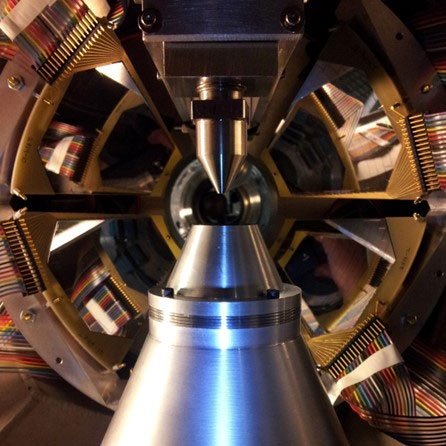The Science
Neutron stars – extremely dense and exotic astronomical objects made almost entirely of neutrons – do not burn nuclear fuel to produce light. Instead, these strange objects can exist in binary systems in which they steal material from nearby “main sequence” stars like our sun. The stolen hydrogen and helium fall onto the neutron star surface. There, the enormous gravitational pull compresses the neutron star until it undergoes repeated explosive nuclear reactions. These reactions create increasingly heavier elements and produce X-ray bursts. Scientists have generally relied on theoretical models to understand these reactions because the isotopes involved often exist for just tiny fractions of a second.
The Impact
Using a unique combination of experimental facilities, researchers directly measured a key reaction that takes place in the explosions on the surfaces of neutron stars. The experiment used the Jet Experiments in Nuclear Structure and Astrophysics (JENSA) helium gas jet target; the high-resolution SuperORRUBA silicon detector array; and a beam of the rare isotope argon-34. This is the first-ever measurement of this reaction. Contrary to expectations, the experimental data agreed with predictions from a common theoretical model used to calculate reaction rates. The study improves scientific understanding of the capabilities of this theoretical model. Researchers use this model across a wide range of applications, including nuclear energy production.
Summary
Researchers measured a nuclear reaction critical to our understanding of X-ray bursts — violent nuclear explosions on the surface of neutron stars. The reaction of argon-34 with a helium nucleus affects the production of emitted X-rays from the explosion and the isotopes left behind after the burst. Researchers used a unique combination of a dense and localized helium gas jet target with high-resolution particle detectors and a rare isotope beam from the ReAccelerated (ReA) beam facility at the former National Superconducting Cyclotron Laboratory, a particle accelerator at Michigan State University operated as a National Science Foundation user facility, to directly measure the rate of the nuclear reaction.
The researchers found that the reaction rate agreed with the predictions from a commonly used theoretical model even though they did not expect it to be valid in this case. Probing the applicability of the theoretical model helps to improve its predictions for a wide range of fields, such as astrophysics, nuclear energy, and nuclear medicine.
Funding
This material is based on work supported by the Department of Energy Office of Science, Office of Nuclear Physics; the National Science Foundation; and the Laboratory Directed Research and Development Program of Oak Ridge National Laboratory. This work was also supported partially by the National Research Foundation of Korea grants funded by the Korean government.
Publications
Browne, J., et al. (JENSA Collaboration), First Direct Measurement Constraining the 34Ar(a,p)37K Reaction Cross Section for Mixed Hydrogen and Helium Burning in Accreting Neutron Stars. Physical Review Letters 130, 212701 (2023). [DOI: 10.1103/PhysRevLett.130.212701]


